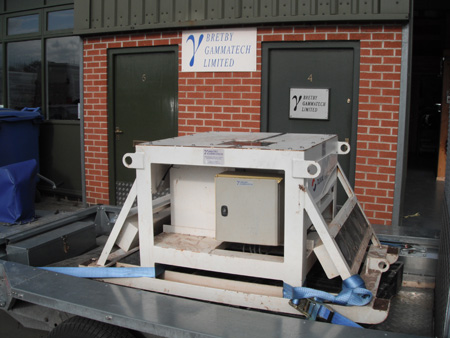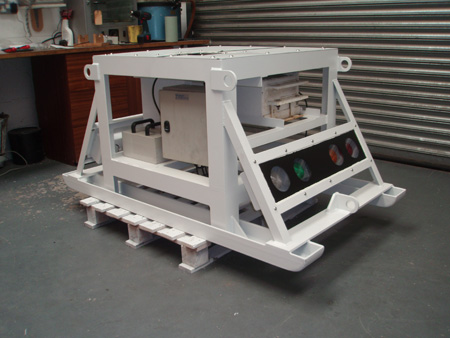-
GammaEye
We have developed two 'Gamma Eye' instruments for measuring the much larger bulk gamma emissions from, for example, material contaminated with NORM (Naturally Occurring Radioactive Material) scales, soil contaminated with fission products – using 137Cs as a marker and redundant concrete shielding – using activation 60Co as a marker.
These instruments are ideal for sites where significant quantities of gamma contaminated material need to be assayed and segregated within a short time frame. The dirt associated with mined coal contains significantly higher concentrations of the naturally emitting radio-nuclides 40K and the Uranium & Thorium series than the coal itself.
A sensitive gross gamma sensor can be calibrated to provide a measurement of the ash content based upon the concentration of these trace radioisotopes in the dirt. Hundreds of Bretby Gammatech systems are in everyday operation in over 200 countries around the world.
Both these instruments have been developed by our technical team in close association with Nuvia Ltd:
-
GammaEye – benefits
- Quick & easy assessment of gamma contaminated material
- Fast throughput (one tonne per minute)
- Reduced measurement time leading to reduced time on site
- Reduced reclamation costs
How it works
The digger driver lowers the bucket onto the monitor frame and once in position the system automatically makes its measurement. After 10 seconds or so one of three lights illuminate – Green for OK, Amber for medium activity and Red for higher activity.
The digger driver can then deposit his load in the appropriate place for subsequent disposal or processing.
Accuracy
The accuracy of the Heat Eye will depend upon the site and the performance of each component sensor. Accuracies of (1 sigma) better than 0.5% on final product and between 1 and 3 % ash with run-of-mine (ROM) have been achieved with production systems.
Precisions in the order of 0.5% are regularly being achieved with final product monitors (Measured to ISO 15239)
GammaEye – features
- Easily calibrated for a range of gamma contaminants
- User selectable alarm levels
- Automated initiation of counting
- Simple traffic light system to indicate alarm level reached
- Safe operation as no personnel need to be close to take meter readings
- Log of measurements maintained which can be downloaded to a PC
- Easy to generate and update background
- No moving parts
- 24 hour battery operation, powered by rechargeable sealed lead acid battery units
- Easy to transport around site
Applications
- Clearance of potentially contaminated land sites
- Remediation work during industrial building work
- Preparation for major housing developments
- Sorting and separating debris for disposal
-
The GammaEye - Bucket MonitorThe Bucket Monitor provides a quick assessment of the bulk gamma contamination of excavated material within the bucket of a mechanical digger. This instrument contains a large scintillation crystal which is mounted within a substantial frame. The sensor is pre-calibrated for the contamination isotope of interest and can be set to alarm for discrete activity bands.
The driver of the mechanical digger rests the bucket containing the excavated material on the frame and after a few seconds it provides him with a visual indication of the level of gamma contamination in the bucket. This indication is provided by a traffic light system - red, amber and green denoting the band within which the gamma contamination occurs.
On the basis of this information the driver deposits the load in the appropriate place for subsequent disposal or processing. During operation no personnel are required to take meter readings which is a key safety feature. Once calibrated the 'Bucket Monitor' is very simple and rapid to use.
No specialist nucleonic knowledge is required by the operator. The driver simply observes and acts upon the traffic light indications. He does not even need to activate the counting process as the instrument automatically senses when the bucket is correctly positioned. This instrument has already found applications at five different sites.
The GammaEye - On-Belt Monitor
The Gamma Eye is a fully on-line system providing a continuous assessment of the gamma activity of a conveyed load. In this instrument a large scintillation crystal is mounted over the conveyor transporting material such as soil, rubble or other bulk debris, suspected of being gamma contaminated.
As with the Bucket Monitor it works on a gross gamma signal and can be pre-calibrated for the contamination isotopes of interest. It provides a visual and audible warning if a user-selectable predetermined gamma count level has been exceeded. The instrument can, for example, provide signals to activate a diverter to deflect material above a specified activity level off the conveyor.
Alternatively, the Control Unit can provide a 'lock out' signal to the conveyor. The conveyor can only be restarted when the offending material, such as a radium dial, has been removed and the gamma count level has reduced to below the set threshold.
The throughput is only limited by the feed rate to and the capacity of the conveyor. As with the bucket monitor there are no moving parts and it is simple to set up and use. The Belt Monitor is powered by a standard 120-240VAC 50Hz supply.
On-Belt Monitor Features:
- Easily calibrated for a range of gamma contaminants
- User selectable alarm level
- Fully on-line automated measurement
- Simple visual and audible warning to indicate alarm level reached
- Log of measurements maintained
- Measurement log can be downloaded to a PC
- Easy to generate and update background
- No moving parts
- 24 hour mains operation
- Easy to set up on site
On-Belt Monitor Benefits:
- Quick & easy assessment of gamma contaminated material
- Fast throughput (only limited by the feed rate to and the capacity of the conveyor)
- Reduced measurement time
- Reduced reclamation costs




